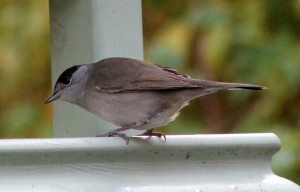 One of the many pleasures of writing these notes is reading the many emails over a very wide range of subjects that are sent to me. The first two months of this year has been no exception with emails ranging from frogs to birds. The first concerned, as many are, wildlife in the garden, which is not surprising as many use this for wildlife observations more than anywhere else. A reader on the edge of Inverness had a blackcap in the garden and wondered if this was unusual and why it was there in the winter as it is normally a summer migrant. This is a frequent query from readers and the answer lies in the fact that these winter birds are not the ones that breed in the summer months. The breeding birds have long since moved south and will be in Iberia and even as far as North Africa. The blackcaps in the garden now are birds from Germany and north-east Europe that over-winter here and seem to be increasing in numbers. Incidentally the males and females are easy to tell apart as the male has a black cap and the female a brown cap. What is interesting is that the summer blackcaps feed on insects whilst the wintering birds will visit bird tables after seed and suet.
One of the many pleasures of writing these notes is reading the many emails over a very wide range of subjects that are sent to me. The first two months of this year has been no exception with emails ranging from frogs to birds. The first concerned, as many are, wildlife in the garden, which is not surprising as many use this for wildlife observations more than anywhere else. A reader on the edge of Inverness had a blackcap in the garden and wondered if this was unusual and why it was there in the winter as it is normally a summer migrant. This is a frequent query from readers and the answer lies in the fact that these winter birds are not the ones that breed in the summer months. The breeding birds have long since moved south and will be in Iberia and even as far as North Africa. The blackcaps in the garden now are birds from Germany and north-east Europe that over-winter here and seem to be increasing in numbers. Incidentally the males and females are easy to tell apart as the male has a black cap and the female a brown cap. What is interesting is that the summer blackcaps feed on insects whilst the wintering birds will visit bird tables after seed and suet.
Sometime the emails from readers are very unusual and such was the case recently when the observation involved a road casualty. Unfortunately a bird flew into a car just a few miles south west of Inverness and was killed. The readers wondered what it could be as they first thought curlew but the beak was far too short. Fortunately with modern technology the readers sent through two emailed pics and I was surprised as this must be a very unusual road casualty. The bird was one of the most secretive of Highland birds – a water rail. This bird, that is smaller than a moorhen, spends most of its time skulking in reeds or other aquatic vegetation and is often overlooked. However, its calls, a series of grunts and squeals can be heard during the day and night and often gives it away. In the old days I used to clap my hands at the side of a reed bed and the squeal of the water rail would often be the reply. Its secretive nature makes it difficult to count but there are estimated to be between 1,250 and 1,400 pairs breeding in Scotland and about 3,000 present in the winter.
There were two emails about the first frogs’ spawn with the first coming from Ardnamurchan, west of Fort William, where the reader had a few frogs that had come into his garden pond. Then the following morning – 16th February – there were a few clumps of frogs’ spawn. Unfortunately the reader also recorded a heron at the pond and, of course, these will eat the frogs. He also recorded an otter running across his garden and here again they will willingly take adult frogs. The second record of frogs’ spawn was few days later on the Black Isle. The site is a small garden pond and, typically for first records of spawn, is near the coast where the weather is slightly milder than inland. The next few weeks will be critical for this early frogs’ spawn as if the water freezes for long periods the eggs will die. Fortunately many frogs do not lay their spawn until much later and stand a better chance to survive, if the herons, otters and many other predators do not get them.
Tags: highland wildlife
